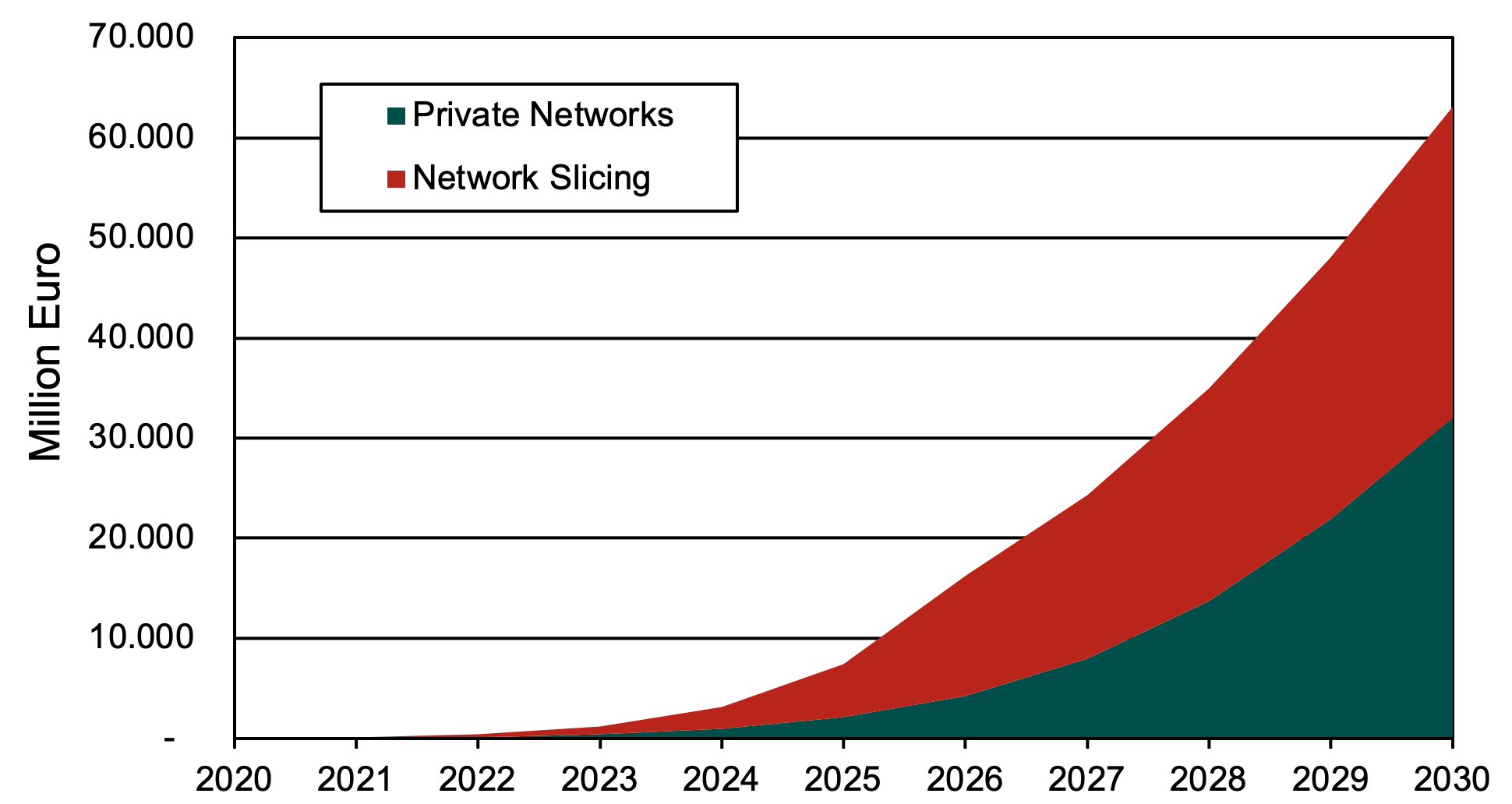Sponsors Article
Campus networks, Network Slicing or PNI-NPN? – a guideline
Total Addressable Market for 5G B2B Applications, Globally Forecasting period 202-2030 (Source: ABI Research)
The story of 5G applications in the industry is certainly not new. Especially in connection with already known trends such as Industry 4.0 (i.e. the progressive digitization of production and manufacturing processes in industry), the application of 5G opens completely new doors for industrial companies to increase their efficiency by optimizing their work processes and thus not having to create avoidable costs (for example, an unexpected loss of production).
Author: Leo Gergs, ABI Research
In particular, the application of 5G mobile networks in industry allows the automation of particularly critical processes (such as maintenance work or emergency shutdown devices for production machines). Furthermore, the use of 5G mobile technology allows factory operators to break away from the rigid concept of solidproductionbased on solid production in order to significantly increase factoryefficiency through, for example, the use of AGVs (for Autonomously Guided Vehicles).
In line with this, the market for 5G in the enterprise verticals will grow to EUR 63 billion by 2030. Traditional industrial markets (i.e. industrial manufacturing, energy production or logistics deployments) will play a crucial role for the 5G enterprise verticals opportunity.
In looking at the enterprise 5G market, we broadly distinguish two different deployment models: On the one hand, the installation of a locally limited campus network is located on the premises of the industrial companies. On the other hand, 5G gives network operators the ability to separate parts of their public mobile network to offer this to individual industrial companies through what is referred to as network slicing. The remainder of the article will examine these individual models in more detail.
Advertisement
Various 5G deployment models for the industry
As previously mentioned, it is generally possible to distinguish the establishment of a separate campus network from the provision of a logically separated part of the public mobile network (a so-called “network slice”) for industrial enterprises. The fundamental difference between these two deployment models is the location of the core network, that processes all control functions for the cellular network. While in the case of a locally deployed private campus network, all network components (i.e., RAN, transport and core network) are deployed on the enterprise premises, a network slices utilises the existing core of the public mobile network. As a result, some sensitive production data (e.g. condition of production machines or other infrastructure) would have to leave the boundaries of their own factory premises in order to be processed in the public core network. In the case of a completely isolated campus network, however, all data can be processed locally and would not have to leave the factory premises.
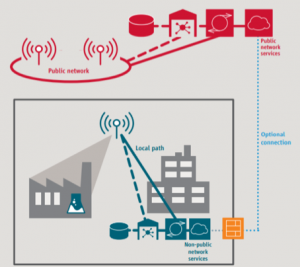
Network architecture of a completely isolated private network.
(Source: 5G-ACIA)
High level of investment required
Thus, while a locally deployed private campus network guarantees the absolute integrity of the data transmitted over the 5G network, the deployment is particularly cost-intensive and results in high total cost of ownership (TCO), as completely new network infrastructure would have to be installed on the campus. In addition, a campus network initially guarantees only localized connectivity for devices located within the boundaries of the specific enterprise deployment. In in order to realize use-cases that require connectivity beyond the boundaries of the respective campus (for example, for the traceability of individual components along the entire supply chain), additional options need to be considered to guarantee connectivity beyond the factory premises. In this context, several additional 5G private network deployment options are emerging that combine parts of the public cellular network to locally installed elements of a campus network. In the telecommunications industry, these models are referred to as “public network integrated non-private networks” (PNI-NPN). Here, too, two different models can be distinguished.
RAN Sharing
One way to integrate private and public mobile networks is to use a common RAN network infrastructure. While a locally installed, separate core network ensures that sensitive factory data (e.g., production data) can continue to be processed locally within the factory premises, it would use the RAN infrastructure (i.e. small cells) deployed for public networks. On the one hand, this significantly reduces the necessary investment volume, as no additional RAN infrastructure needs to be installed. On the other hand, it makes it possible to use existing wide area networks (WAN) to connect materials and components beyond their own campus. As network traffic would be separated within the small cell, full integrity of the enterprise data could be guaranteed.
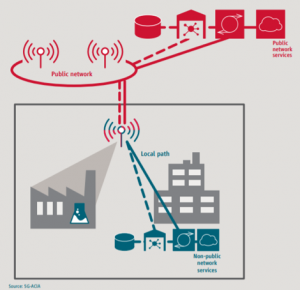
Network architecture RAN Sharing (source: 5G-ACIA)
RAN & Control Plane Sharing
In addition to private and public network sharing only the RAN infrastructure, there is the possibility for private and public network to also share certain network functions (the so-called “control plane”) of the core network (illustrated in next Figure).
Specifically, this allows the outsourcing of certain control functions of the 5G network into the hands of public mobile network operators. Network data (the so-called “user plane”) could remain on the enterprises premises by deploying a local edge.
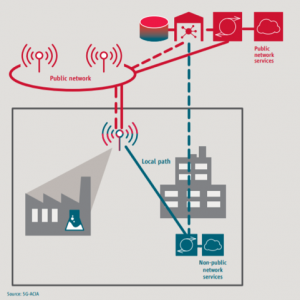
Network architecture RAN & Control Plane Sharing (Source: 5G-ACIA)
Which network model for which application?
Having discussed the different deployment models for enterprise 5G, industrial companies must therefore carefully consider which model meet their technology requirements based on the use cases that they want to address through this 5G deployment. The choice of a specific 5G campus network model therefore depends to a large extent on three factors.
- Coverage area requirements
- Network customizability requirements (such as, the ability to create & customize your own network slices)
- Network integrity requirements
With these three criteria in mind, the decision-making processes shown in Figure 5 serve as a decision guide to facilitate a smooth entry into 5G deployments, especially for small and medium-sized enterprises (SMEs).
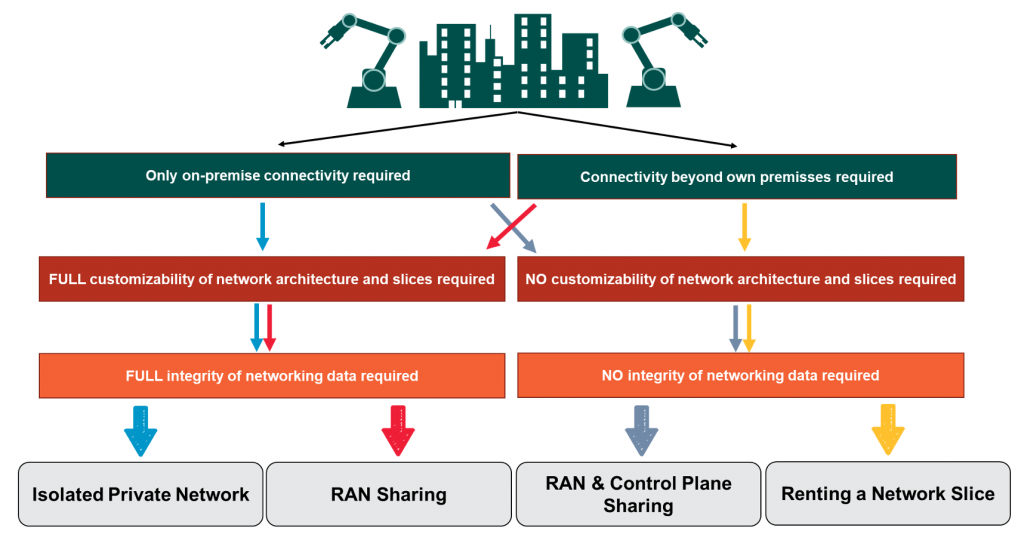
About the Author
Leo Gergs leads the Private Networks & Enterprise 5G Research at the technology consulting Firm ABI Research. Leo has a special focus on the commercialization of 5G, covering 5G use cases across several enterprise verticals and their financial impact. As part of this, he builds strategy advice for leading carriers and infrastructure vendors on how to design product offerings and business models for enterprise 5G.
For more information visit his profiles on LinkedIn or Twitter.

